 W
WAcanthognathus ocellatus is a species of ant belonging to the genus Acanthognathus. Described in 1887 by Mayr, the species is native to South America and other regions.
 W
WAndricus dentimitratus is a gall forming wasp in the genus Andricus. The adults lay their eggs on various species of oak and the developing larvae causes the trees to create a large ornate gall. The oaks parasitised include Quercus frainetto, Q. petraea, Q. pyrenaica, Q. pubescens and Q. robur. The gall is formed out of the cup of the acorn. In cross-section it resembles a mushroom. It is woody, maroon, shiny and sticky. It grows up to 25 mm high and 20 mm wide. What resembles the head of the mushroom is lobed or toothed in various ways. The insect emerges from the narrowing, between the head and base.
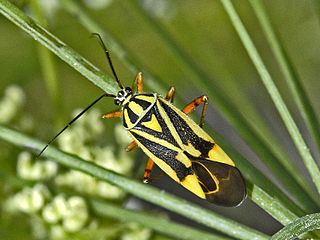 W
WBrachycoleus decolor is a species of plant-feeding insects of the family Miridae.
 W
WBrachythemis fuscopalliata, the dark-winged groundling, is a species of dragonfly in the family Libellulidae. It is found in Iran, Iraq, Israel, Syria, and Turkey. Its natural habitats are rivers, swamps, freshwater lakes, freshwater marshes, water storage areas, ponds, open excavations, irrigated land, and canals and ditches. It is threatened by habitat loss.
 W
WCamponotus cinctellus, commonly known as the shiny sugar ant, is a species of sugar ant with an extensive range in the eastern Afrotropics.
 W
WCrematogaster corticicola is a species of ant in tribe Crematogastrini. It was described by Mayr in 1887.
 W
WDolichoderus beccarii is a species of ant in the genus Dolichoderus. Described by Emery in 1887, the species is endemic to Borneo and Indonesia.
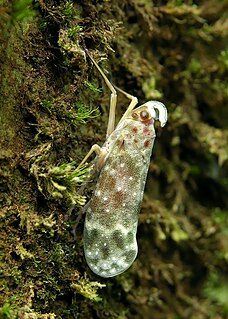 W
WEnchophora sanguinea is a species of lantern bug, a type of hemipteran, found in Central and South America. It was first described by William Lucas Distant in 1887. They are 25 millimetres (1.0 in) long. Their colour varies, but is normally red to green; they have a scimitar-shaped process on their heads. They feed on the sap of trees, most commonly Simarouba amara, and they excrete honeydew out of their anuses.
 W
WEristalinus fuscicornis is a species of hoverfly. It is found in Kenya, Uganda, Tanzania, Angola, Zimbabwe, Congo, Sudan.
 W
WExoprosopa divisa is a species of bee flies in the family Bombyliidae.
 W
WGnamptogenys triangularis is a Neotropical species of ants in the subfamily Ectatomminae. Native to the forests of South and Central America, G. triangularis is a predatory ant that feeds on millipedes. In its native range, this species is known from Buenos Aires, Argentina in the south to Costa Rica in the north, with records from eight countries in South America, and two countries of Central America. The first records of G. triangularis outside its native range came from Florida beginning in 1985 and Alabama in 1996.
 W
WHeteroponera carinifrons is a species of ant in the genus Heteroponera, endemic to Chile. It was described by Mayr in 1887.
 W
WHypoponera opaciceps is a species of ant in the family Formicidae.
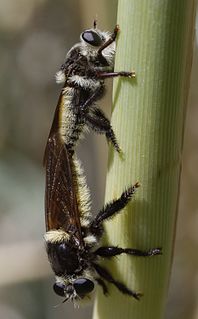 W
WMallophora fautrix is a species of robber flies in the family Asilidae.
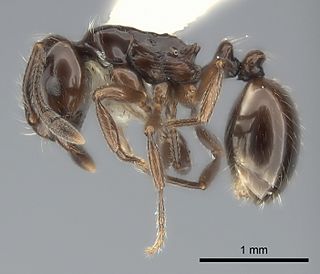 W
WMonomorium bidentatum is a species of ant in the subfamily Myrmicinae. It is endemic to two South American countries, Chile and Argentina.
 W
WOsmia cornifrons, also known as the horned-face bee, are solitary bees indigenous to Northern Asia. Physically, this species of bee is recognized for its horn-like extensions originating from its lower face. Populations of O. cornifrons have been recorded in multiple locations, including Japan, Korea, China, and Russia. O. cornifrons are more docile as compared to other species of bees and are less prone to sting when aggravated.
 W
WParaxenetus guttulatus is a species of plant bug in the family Miridae. It is found in North America.
 W
WPhasia barbifrons is a European species of fly in the family Tachinidae.
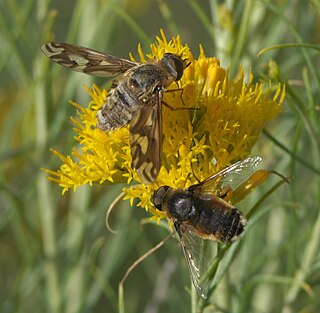 W
WPoecilanthrax willistoni, Williston's bee fly or sand dune bee fly, is a member of the Bombyliidae insect family. This family includes the bee flies, true flies that have developed Batesian mimicry characteristics to avoid predators. That is, they look like bees because that helps them avoid bee-wary predators, but they lack stingers.
 W
WPolistes jokahamae is a species of paper wasp from Japan.
 W
WPromachus yesonicus, or shioya-abu in Japanese, is a species of robber flies. In Japanese, "shioya" means a salt merchant, and "abu" means a horse-fly. This insect is called "shioya-abu" because the males have a white tip to their tail that resembles salt.
 W
WSericomyia bifasciata is a species of syrphid fly in the family Syrphidae.
 W
WStonemyia fera is a species of fly in the family Tabanidae.
 W
WTenthredopsis friesei, the common sawfly, is a species belonging to the family Tenthredinidae.
 W
WTetrix ceperoi, Cepero's groundhopper, is a member of the family Tetrigidae and is very similar to common grasshoppers. Grasshopper is defined as a "plant eating insect with long hind legs that are used for jumping and for producing a chirping sound". However, unlike the common grasshopper, the wings of T. ceperoi extend beyond its pronotum. The front wings have evolved throughout history to be stumps, and the back wings are very well developed. Thanks to the front wings only, T. ceperoi is capable of flying. Furthermore, T. ceperoi sports wide shoulders while covering its narrow abdomen beneath the pronotum. T. ceperoi are classified as Orthoptera, which describes crickets, grasshoppers, and locusts. Furthermore, these Orthoptera have incomplete metamorphosis, which also affects sexual dimorphism later. T. ceperoi reach an average length of about 10 millimetres (0.39 in). T. ceperoi is a multi-coloured ground dweller with the ability to blend into its surroundings. The ability of T. ceperoi to be different colours makes it able to evolve colour schemes better adapted to specific habitats. This cryptic nature of their outer layer provides protection from predators as it is able to blend into its surroundings. T. ceperoi is diurnal, which means it is solely active in the daytime. However, although it is diurnal, it continues to hibernate during a late nymphal instar or later on in life as adults.